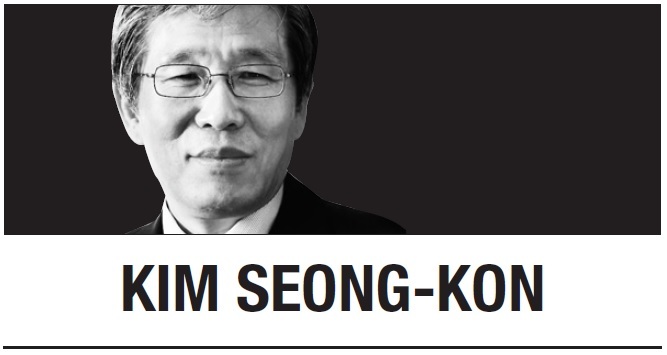[Kim Seong-kon] The Divided States of America vs. divided Korea
By Kim Seong-konPublished : Feb. 10, 2021 - 05:31

The resemblance between the two countries was ironic because they were, at least officially, politically opposite. One was supposedly liberal and the other was presumably conservative. It implies that if pushed to the extreme, the Left and the Right are alike. In fact, the South Korean ruling party, the Democratic Party, has turned out to be quite old school, far from being liberal or progressive in its nature, despite its beguiling name and claim. Likewise, the Republican Party during the Trump administration frequently defied conservative values such as protecting tradition, social institutions and personal freedom. Both administrations unabashedly displayed hypocrisy and dishonesty. They also seriously lacked decency, an honor code or any sense of noblesse oblige.
Recently, Stanford University hosted an intriguing panel discussion titled “Are South Korean Liberals Truly Liberal?” The discussion shed light on the identity of the Moon administration, mistakenly known as “liberal” in the international community. The flier states: “South Korea has won praise for exhibiting democratic resilience through ‘candlelight protests’ and a presidential impeachment. But South Korea’s democracy has likewise begun to show signs of decay, as democratic norms and spirits have been violated under the guise of rule of law. Troublingly, this trend has been growing under the government led by former pro-democracy activists.”
Recently, CNN broadcast a special feature titled “The Divided States of America.” The title was both poignant and disheartening because it painfully depicted the contemporary sociopolitical landscape of America. In that intriguing program, CNN analyzed and deplored the current predicament of America, torn by two warring factions: Red States and Blue States, Republicans and Democrats, the inherited and the disinherited.
America once inspired many Europeans and later Asians as a symbol of democracy and cultural diversity. For example, in his monumental essay “What is an American?” published in 1782, Hector St. John Crevecoeur wrote, “The American is a new man, who acts upon new principles: He must therefore entertain new ideas and form new opinions. Here individuals of all nations melt into a new race of men whose labors and posterity will one day cause great changes in the world.” Then he continued, “Here there are no aristocratic families, no courts, no kings, no bishops, and no great manufacturers employing thousands.”
Today, however, foreigners find that America has lost its exuberant image and the American people are facing the harsh reality of an incorrigibly divided nation that jeopardizes democracy and diversity. Watching the rioters on Capitol Hill in Washington, intimidating senators and members of Congress, those who had admired the United States were appalled at the nightmare landscape and lamented the crisis of democracy in America.
F. Scott Fitzgerald already knew that America would not remain what it was when he wrote “The Great Gatsby” in 1925. In that monumental novel, Fitzgerald lamented that the “fresh, green breast of the new world” that “flowered once for Dutch sailors’ eyes” was gone. He portrayed his protagonist, Gatsby, as a naive subscriber to the original American Dream. Fitzgerald wrote, “He did not know that it was already behind him, somewhere back in that vast obscurity beyond the city, where the dark fields of the republic rolled on under the night.”
Likewise, South Korea has lost her original dream and has become a nation sharply divided along ideological, regional and class lines. As a result, we see an unbridgeable chasm and unmitigated hostility between the Left and the Right, eastern provinces and western ones, and the rich and the poor, not to mention the conservatives and the progressives.
In 1941, Winston Churchill admonished, “United we stand. Divided we fall.” Syngman Rhee, the first president of South Korea, warned, “United we live. Divided we die.” Still, people would not listen to the political prophets. As a result, we are now watching the two hopelessly divided nations with a heavy heart.
In a divided nation one can inevitably see the deterioration of democracy, complete with authoritarian governments and a totalitarian social milieu. To overcome the crisis, we need to unite under the banner of democracy, the free market economy, human rights and freedom, following US Sen. Bob Menendez’s recent advice. We also have to value and appreciate our friendships with our allies, who will come to rescue us in times of crisis. Otherwise, we are vulnerable to the “divide and conquer” policy of neighboring hostile nations.
Kim Seong-kon
Kim Seong-kon is a professor emeritus of English at Seoul National University and a visiting scholar at Dartmouth College. -- Ed.







![[Graphic News] More Koreans say they plan long-distance trips this year](http://res.heraldm.com/phpwas/restmb_idxmake.php?idx=644&simg=/content/image/2024/04/17/20240417050828_0.gif&u=)
![[KH Explains] Hyundai's full hybrid edge to pay off amid slow transition to pure EVs](http://res.heraldm.com/phpwas/restmb_idxmake.php?idx=644&simg=/content/image/2024/04/18/20240418050645_0.jpg&u=20240419100350)





![[From the Scene] Monks, Buddhists hail return of remains of Buddhas](http://res.heraldm.com/phpwas/restmb_idxmake.php?idx=652&simg=/content/image/2024/04/19/20240419050617_0.jpg&u=20240419175937)

![[KH Explains] Hyundai's full hybrid edge to pay off amid slow transition to pure EVs](http://res.heraldm.com/phpwas/restmb_idxmake.php?idx=652&simg=/content/image/2024/04/18/20240418050645_0.jpg&u=20240419100350)

![[Today’s K-pop] Illit drops debut single remix](http://res.heraldm.com/phpwas/restmb_idxmake.php?idx=642&simg=/content/image/2024/04/19/20240419050612_0.jpg&u=)